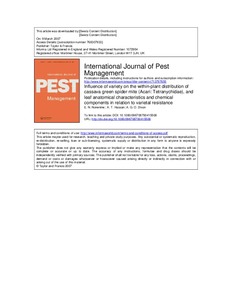| dc.contributor.author | Nukenine, E. |
| dc.contributor.author | Hassan, A. |
| dc.contributor.author | Dixon, A. |
| dc.date.accessioned | 2019-12-04T11:21:12Z |
| dc.date.available | 2019-12-04T11:21:12Z |
| dc.date.issued | 2000 |
| dc.identifier.citation | Nukenine, E., Hassan, A. & Dixon, A. (2000). Influence of variety on the within-plant distribution of cassava green spider mite (Acari: Tetranychidae), and leaf anatomical characteristics and chemical components in relation to varietal resistance. International Journal of Pest Management, 46(3), 177-186. |
| dc.identifier.issn | 0967-0874 |
| dc.identifier.uri | https://hdl.handle.net/20.500.12478/3704 |
| dc.description.abstract | The within-plant distribution of the cassava green spider mite, Mononychellus tanajoa Bondar, and the anatomical characteristics and the chemical components relating to varietal resistance of cassava, were studied using 11 cassava genotypes with varying levels of resistance for two dry seasons and one wet season. The results show that M. tanajoa aggregates on the top leaves of cassava at low levels of resistance as compared with a more even within-plant distribution at higher levels of resistance. Thus, for accurate sampling of mite populations, it might be important to consider young and old leaves, not just the young leaves, in fields containing resistant and susceptible cassava genotypes. Correlations between the anatomical characteristics and mite population density and damage scores were not consistent across months, either within or over seasons. This suggests that leaf anatomical characteristics may not be important in the varietal resistance of cassava to M. tanajoa. During the dry season, mite population density was positively correlated with leaf nitrogen, potassium and phosphorus and negatively correlated with leaf calcium and fat. Only calcium was negatively associated with mite damage at the peak of the dry season (January 1993 and 1994). Breeding cassava genotypes with high levels of leaf calcium and fat, and low levels of leaf nitrogen, potassium and phosphorus, may improve the level of resistance to M. tanajoa. |
| dc.language.iso | en |
| dc.subject | Mononychellus Tanajoa |
| dc.subject | Cassava |
| dc.subject | Within-Plant Distribution |
| dc.subject | Anatomical Characteristics |
| dc.subject | Chemical Components |
| dc.title | Influence of variety on the withinplant distribution of cassava green spider mite (Acari: Tetranychidae), and leaf anatomical characteristics and chemical components in relation to varietal resistance |
| dc.type | Journal Article |
| dc.description.version | Peer Review |
| cg.contributor.affiliation | International Institute of Tropical Agriculture |
| cg.contributor.affiliation | University of Ibadan |
| cg.coverage.region | Africa |
| cg.coverage.region | West Africa |
| cg.coverage.country | Nigeria |
| cg.isijournal | ISI Journal |
| cg.authorship.types | CGIAR and developing country institute |
| cg.iitasubject | Cassava |
| cg.iitasubject | Diseases Control |
| cg.iitasubject | Livelihoods |
| cg.iitasubject | Plant Breeding |
| cg.iitasubject | Farm Management |
| cg.iitasubject | Pests Of Plants |
| cg.iitasubject | Aflatoxin |
| cg.iitasubject | Plant Diseases |
| cg.iitasubject | Handling, Transport, Storage And Protection Of Agricultural Products |
| cg.iitasubject | Genetic Improvement |
| cg.iitasubject | Food Security |
| cg.iitasubject | Plant Genetic Resources |
| cg.iitasubject | Plant Health |
| cg.iitasubject | Plant Production |
| cg.accessibilitystatus | Limited Access |
| local.dspaceid | 95859 |
| cg.identifier.doi | https://doi.org/10.1080/096708700415508 |

